Historic ship advances ocean science on year-long One Ocean Expedition
When the three-masted bark Statsraad Lehmkuhl sailed past Norway's 12th-century Håkon's Hall and out of Bergen Harbor to begin its year-long Atlantic journey on April 11, 2025, it cast a figure straight out of the history books...even as it set out to guide ocean sciences into the future.
Beneath the billowing sails of the 98-meter (322-foot) steel-hulled vessel from 1914, scientists of the One Ocean Expedition will use state-of-the-art monitoring instruments to explore the Atlantic and Arctic oceans and the Mediterranean Sea. An important part of their mission, particularly in the little-studied Northwest Passage, will be validating and fine-tuning water quality data captured by satellites orbiting miles above.
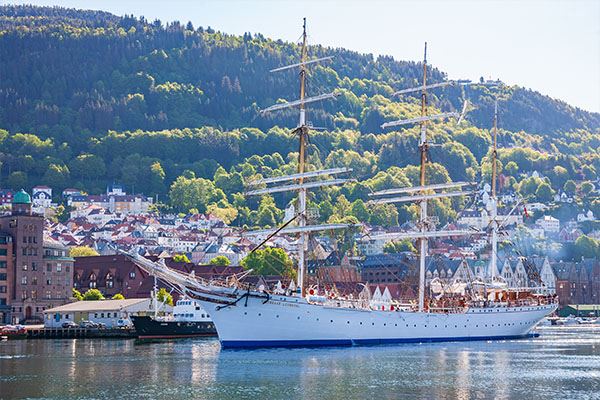
The three-masted Statsraad Lehmkuhl was built in 1914 as a training ship. Today, it carries state-of-the-art water quality sampling equipment that will help advance our understanding of the oceans.
"There is apparently a discrepancy between what you measure in the surface water in the Northwest Passage and what you see from the satellites passing over the area," explains Anders Tengberg, Product Manager of Underwater Sensors for Aanderaa. "For the leg of the One Ocean Expedition that will sail the Northwest Passage, there will be scientists from the European Space Agency aboard."
Tengberg notes that there are four water quality measuring systems aboard the Statsraad Lehmkuhl:
- An Aanderaa SooGuard flow-through system;
- A cabled system that can be lowered to 1,000 meters (3,280 feet) when the ship is stopped to measure salinity, oxygen, pH, temperature, particles, and chlorophyll, with the capability of taking water samples to analyze for ecosystem DNA and microplastics;
- A SonTek CastAway-CTD instrument that can be deployed easily with a fishing rod, even when the ship is underway, to measure conductivity, temperature, depth, and sound speed;
- Advanced acoustic sensors mounted to the hull that measure currents as well as suspended sediments, plankton, and fish below the ship.
"You can see algae blooms from space, but their depth distribution and how they rise and sink are difficult to understand without local measurements," Tengberg adds. "There are also many species of algae, some of which have silica shells, some of which have calcium shells. The scientists on the Statsraad Lehmkuhl will be taking filter samples of the algae so they can understand what types of blooms the satellites are seeing."
Tengberg was aboard the Statsraad Lehmkuhl for the crucial first few days of its voyage. His role was more than just drawing on his long experience as a competitive sailor to help hoist sails and stand watch on deck. Tengberg is also a leading expert on optical oxygen sensors and other water quality monitoring.
As the ship caught fair winds on its way to the Shetland Islands, Tengberg worked closely with One Ocean Expedition research coordinators Lucie Cassarino and Natacha Fabregas to test the Xylem equipment that they will be using all year long to measure water quality and dynamics.
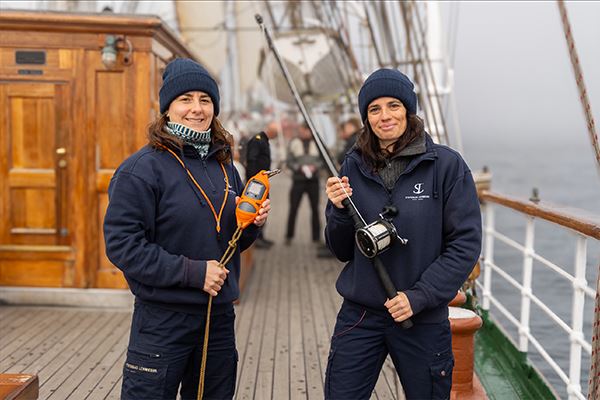
French marine scientists Lucie Cassarino (left) and Natacha Fabregas (right) with the SonTek CastAway-CTD system aboard the Statsraad Lehmkuhl. The duo coordinates all scientific activities on board during the year-long One Ocean Expedition, using instruments like this compact CTD that can be deployed with a simple fishing rod. Learn more about their work.
Detailed data
The SooGuard flow-through system features an Aanderaa Optical Optode oxygen sensor as well as sensors for salinity, temperature, and flow through the chamber. Another sensor package to measure turbidity, chlorophyll a, and a proxy for blue-green algae will be installed soon.
Tengberg points out that Aanderaa was the first company to manufacture medical research-grade optical oxygen sensors capable of leaving the lab and being deployed in the depths of the Mariana Trench and other harsh, deep-sea environments.
"Shallow water, to us, is 3,000 meters (9,842 feet)," he notes. "These sensors are designed to go to the deepest parts of the ocean and stay there for a year or two, along with our harsh-environment SmartGuard datalogger. Our optical oxygen sensor has been cited in over 200 academic papers. They are 40-point calibrated instead of just a few points."
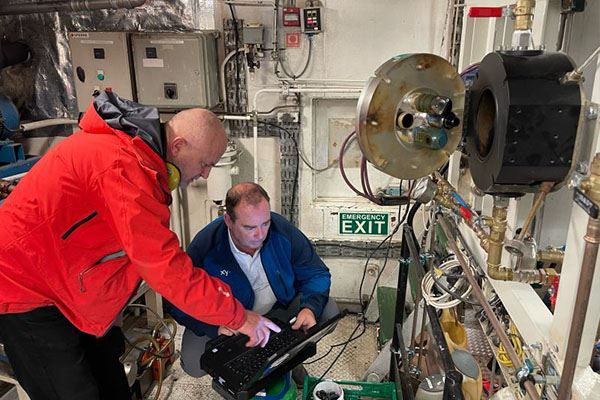
Aanderaa's Anders Tengberg (left) and Xylem's Jon Fajans (right) check data from an Aanderaa SooGuard flow-through system, which is gathering extensive data as the Statsraad Lehmkuhl's One Ocean Expedition.
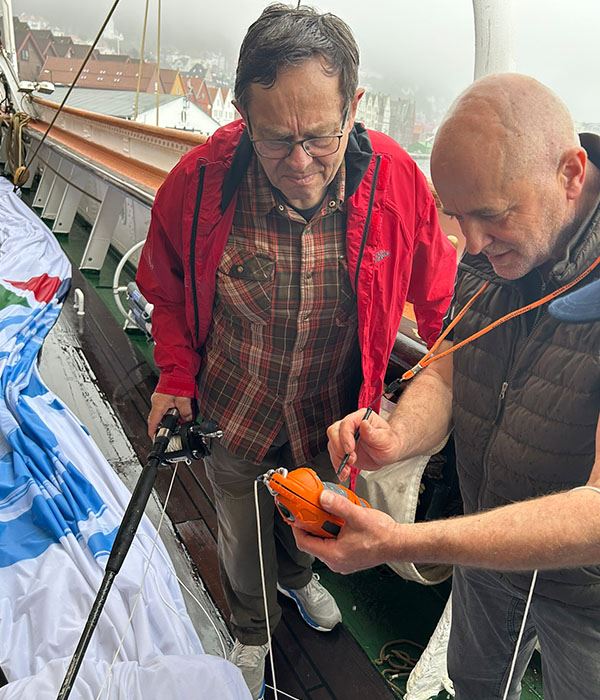
Aanderaa's Anders Tengberg (right) checks data on a SonTek CastAway-CTD onboard the Statsraad Lehmkuhl.
Specially outfitted
The Statsraad Lehmkuhl was specially outfitted with a copper/nickel intake pipe five meters (16 feet) below the waterline to optimize the performance of the continuous water sampling and the SooGuard system, notes Tengberg.
He explains that dozens of SooGuard systems have been connected to cooling water intakes on ferries, supply ships, and other "vessels of opportunity" over the years to gather data on ocean and bay environments as the craft have gone about their business.
However, he notes, the resolution of the data they collected could be a bit low due to the 15-to-20-knot speeds of the vessels and the great length of some of the cooling supply lines. On some of those vessels of opportunity, water traveled 90 seconds or more before reaching the instruments, making it difficult to pinpoint where it was collected. Cooling systems also impacted the quality of the water that reached the sensors.
"It became very complicated," Tengberg says. "If the water goes through a long system, the oxygen might change. Temperature will definitely change. And the high-speed centrifugal pumps on commercial vessel cooling systems are too violent for collecting algae and microplastics."
In contrast, the Statsraad Lehmkuhl is likely to average 10 knots in good wind, and the short, custom-fitted intake will deliver water samples to the SooGuard system in a few seconds with minimal impact on its properties and contents. That will allow Cassarino, Fabregas, and their guest scientists to gather highly accurate, high-resolution water quality data as well as collect intact samples of algae and microplastics, Tengberg points out.
Great flexibility
The CastAway-CTD is a revolutionary, hand-held instrument that provides instantaneous, GPS-positioned measurements of conductivity, temperature, depth, and sound speed. Users can lower the CastAway to depths of up to 100 meters (328 feet) with a fishing rod.
Unlike the One Ocean Expedition's meter-tall, cable-and-winch-deployed system that can gather data as deep as 1,000 meters (3,280 feet) below the surface—which requires the ship to be stationary—the fist-sized CastAway can be used at rest or even when the Statsraad Lehmkuhl is moving slowly.
"The CastAway gives you much more possibilities of doing quick measurements," says Tengberg. "Over the years, I have often used the CastAway to cross-calibrate data and determine if a sensor on our deployed instruments has issues with biofouling. It's a great tool."
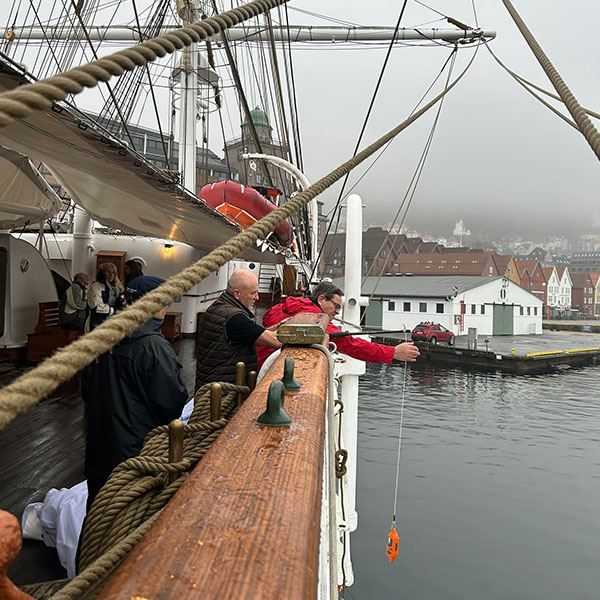
Anders Tengberg of Aanderaa (center) uses a fishing rod to lower a SonTek CastAway-CTD for a quick, accurate measurement of salinity, temperature, depth, and sound speed.
Schedule
The Statsraad Lehmkuhl was constructed in Germany in 1914 as a training vessel for the German Merchant Marine and christened the Grossherzog Frederich August. Ownership of the steel-hulled ship transferred among Germany, Britain, and Norway during and after the World Wars. Now owned by the Statsraad Lehmkuhl Foundation in Norway, she continues her training mission with a scientific bent.
Each leg of the One Ocean Voyage of the Statsraad Lehmkuhl will see a turnover of guests booked aboard for science, seamanship, or tourism packages. In each port the ship visits, the crew will engage the local public with educational programs about ocean sustainability.
In addition to the Arctic conditions of the Northwest Passage, the One Ocean Expedition includes tropical waters as it circumnavigates North America, including a transit of the Panama Canal (where the crew will pass a pair of Aanderaa DB1750 Motus automated buoys that are reporting on wind, wave, and current conditions in real time at both ends of the canal).
After re-crossing the North Atlantic from the southern U.S., the route will visit France's Mediterranean ports before heading back to the ship's home port in Bergen in late April, 2026—just in time for the annual One Ocean Week, during which local maritime research institutes and industries share their experiences, discoveries, and innovations with the public.
Ports of call include:
- Tromsø, Norway; April 20, 2025
- Reykjavik, Iceland; May 5, 2025
- Nice, France; June 3, 2025
- Ponta Delgada, The Azores; July 2, 2025
- Nuuk, Greenland; July 29, 2025
- Pond Inlet, Greenland; August 13, 2025
- Gjoa Haven, Canada; August 22, 2025
- Cambridge Bay, Canada; August 29, 2025
- Whittier, Alaska, USA; October 4, 2025
- Vancouver, BC, Canada; October 17, 2025
- Seattle, Washington, USA; October 22, 2025
- San Francisco, California, USA; November 3, 2025
- San Diego, California, USA; November 11, 2025
- La Paz, Mexico; November 24, 2025
- Herradura, Costa Rica; December 9, 2025
- Cartagena, Colombia; December 22, 2025
- Norfolk, Virginia, USA; January 31, 2026
- Cadiz, Spain; March 1, 2026
- Ponta Delgada, The Azores; March 14, 2026
- Brest, France; March 27, 2026
- Dublin, Ireland; April 6, 2026
- Bergen, Norway; April 17, 2026
The voyage promises a year of discovery—a classic sailing ship with a modern suite of sensors that will help bring northern seas into focus.
"Especially in these remote areas where the Statsraad Lehmkuhl will sail—the Northwest Passage, for example—where ships rarely go, having a vessel that is equipped with really high-quality sensor systems will provide us a chance to combine these measurements and understand much more the ongoing processes in the water," says Tengberg.
Learn more about the Statsraad Lehmkuhl's One Ocean Expedition.
Ready to advance your own water quality research?
Whether you're planning baseline monitoring, algal bloom detection, or any other environmental project, our technology experts can help you select the right instruments for your unique needs.
Book a free virtual consultation and discover how our state-of-the-art monitoring instrumentation can support your research goals.
